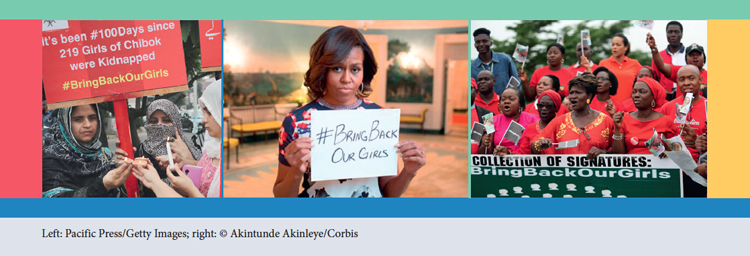Everything Is an Argument
1
Everything Is an Argument

On May 7, 2014, First Lady of the United States Michelle Obama turned to new media to express her concern over the kidnapping of more than 200 young Nigerian girls by the terrorist group Boko Haram. Her tweet, along with an accompanying photo highlighting the trending hashtag #BringBackOurGirls, ramped up an argument over what the international community could do to stop an organization responsible for thousands of deaths in northeastern Nigeria. In bringing her appeal to Twitter, the First Lady acknowledged the persuasive power of social media like Facebook, YouTube, Instagram, and innumerable political and social blogs. The hashtag itself, it would appear, had become a potent tool for rallying audiences around the globe to support specific ideas or causes. But to what ends?

Just weeks before Obama’s notable appeal, a U.S. State Department spokesperson Jen Psaki drew attention with a tweet of her own aimed at countering attempts by Russian social media to co-opt the U.S. State Department’s #UnitedforUkraine hashtag:

The Russian government, it seems, having just annexed the Crimea region and threatening all of Ukraine, was showing more skill than Western nations at using Twitter and other social media to win propaganda points in the diplomatic crisis. Yet Psaki’s response via Twitter earned her disapproval from those who interpreted her social media riposte as further evidence of U.S. weakness. For instance, Texas senator Ted Cruz tweeted in reply to Psaki:

Even Michelle Obama took heat for her earnest appeal on behalf of kidnapped girls the same age as her own daughters. While celebrities such as Amy Poehler and Mary J. Blige posted supportive items, Obama’s tweet got quick international pushback from those who argued (in 140 characters) that the anti-terrorist use of drones by the U.S. military was no less reprehensible than the tactics of Boko Haram. And domestic critics saw Obama’s message as a substitute for real action, with columnist Jeffrey Goldberg chiding well-intentioned activists with a dose of reality:

Clearly, social media play out on crowded, two-way channels, with claims and counterclaims whizzing by, fast and furious. Such tools reach audiences and they also create them, offering an innovative way to make and share arguments. Just as important, anyone, anywhere, with access to a phone, tablet, or other electronic device, can launch arguments that circle the globe in seconds. Social networking and digital tools are increasingly available to all.
We’ve opened this chapter with dramatic, perhaps troubling, examples of Twitter controversies to introduce our claim that arguments are all around us, in every medium, in every genre, in everything we do. There may be an argument on the T-shirt you put on in the morning, in the sports column you read on the bus, in the prayers you utter before an exam, in the off-the-cuff political remarks of a teacher lecturing, in the assurances of a health center nurse that “This won’t hurt one bit.”
The clothes you wear, the foods you eat, and the groups you join make nuanced, sometimes unspoken assertions about who you are and what you value. So an argument can be any text — written, spoken, aural, or visual — that expresses a point of view. In fact, some theorists claim that language is inherently persuasive. When you say, “Hi, how’s it going?” in one sense you’re arguing that your hello deserves a response. Even humor makes an argument when it causes readers to recognize — through bursts of laughter or just a faint smile — how things are and how they might be different.
More obvious as arguments are those that make direct claims based on or drawn from evidence. Such writing often moves readers to recognize problems and to consider solutions. Persuasion of this kind is usually easy to recognize:
The National Minimum Drinking Age Act, passed by Congress 30 years ago this July, is a gross violation of civil liberties and must be repealed. It is absurd and unjust that young Americans can vote, marry, enter contracts, and serve in the military at 18 but cannot buy an alcoholic drink in a bar or restaurant.
— Camille Paglia, “The Drinking Age Is Past Its Prime”
We will become a society of a million pictures without much memory, a society that looks forward every second to an immediate replication of what it has just done, but one that does not sustain the difficult labor of transmitting culture from one generation to the next.
— Christine Rosen, “The Image Culture”
RESPOND •
Can an argument really be any text that expresses a point of view? What kinds of arguments — if any — might be made by the following items?
a Boston Red Sox cap
a Livestrong bracelet
the “explicit lyrics” label on a best-selling rap CD
the health warnings on a package of cigarettes
a Tesla Model S electric car
a pair of Ray-Ban sunglasses